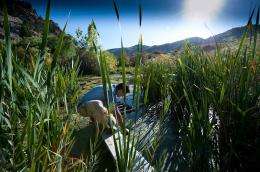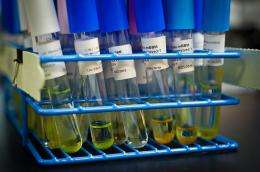Utilizing algae's potential for a better tomorrow

Most people scorn algae as pond scum, but Lee Elliott embraces the slime, captures it, filters it, and analyzes it for its potential to grow like weeds and fuel the airplanes and automobiles of tomorrow.
Elliott is a 21st century prospector. His Eldorado isn't gold, but that elusive briny pond or brackish puddle that houses an algal species that both is rife with oil and multiplies quickly.
Elliott, a graduate student at the Colorado School of Mines and a researcher at the U.S. Department of Energy's National Renewable Energy Laboratory, logged 3,500 miles last year driving his car across the West in search of promising algae.
Eight times, his tires went flat in the deserts of the Southwest while searching for saline lakes. But it wasn't until last month, as he was looking for a few last samples close by NREL's Golden, Colo., campus, that he had an encounter with a prairie rattlesnake — a four-foot diamondback.
"The rattlesnake was a surprise," Elliott said. "I'm always on the watch for them when I'm sampling, and this is the time of year for rattlesnakes in Colorado. They're out there for their last bit of sun. It just happened to be sitting right where I wanted to be."
With nonchalance, he grabbed a six-foot tree limb, picked up the rattler, and deposited the snake out of harm's way.
Following Back Roads to Brackish Waters, Promising Algae
When he's not transplanting rattlers, Elliott searches for algae everywhere: in rivers, ponds, lakes and puddles, in red, green, purple, brown or orange muck. Along with road maps, he carries a portable lab, a large Tupperware box with a water quality meter, several filters, and other sampling equipment.
He dips his sampler into dirty water, measures its salinity and pH, and filters it to remove debris and organisms that might graze on the algae. He pinpoints the location via geo-positioning satellite.
City and suburban dwellers need a lot of fresh water, and farms, trees, plants and livestock need much of the rest. But microalgae can grow in brackish, saline, or brine water that can't be used by humans, farms, ranches or nurseries. So, microalgae have a clear advantage over other biofuel crops in that they can use this marginal water source – including all the water in the oceans.
Not only do algae grow in unlikely settings, but their ability to convert the light they receive into biomass has the potential to outperform that of land plants. Trees, grasses and shrubs typically are not very efficient in capturing and converting the sun's energy into biomass, but some algae are believed to be capable of much higher efficiencies, with some scientists thinking ideal strains may be able to approach the maximum theoretical photosynthetic efficiency under the right conditions.
To help increase the nation's energy security and to ease pollution, President Obama has called for the production of 36 billion gallons of biofuels by 2022. This fall, the U.S. House of Representatives passed the Algae-based Renewable Fuel Promotion Act which would put algae on tax parity with cellulosic biofuels – both qualifying for a $1.01 per gallon production tax credit and a 50 percent bonus depreciation for biofuel plant property.

The search for fast-growing, oil-producing algae is made more difficult by the fact that algae tend to produce oily lipids when they're under stress – but that same stress tends to inhibit their growth.
So, Elliott searches widely, looking for sites with a variety of water chemistry, ranging from fresh water to saturated brine solutions.
The Great Salt Lake, for example, is several times as salty as sea water, depending on the water levels, yet many species of algae thrive there.
Elliott found algae growing in evaporation basins in Nevada where the salinity was so high it was on the verge of precipitation.
"I got a very good idea of how much salt there is in the southwest," Elliott said. "There is a lot of barren wasteland out there where you can dig a basin, fill it with salty water from a brackish, saline, or brine aquifer, put some algae in and they can grow just fine."
The Algae Advantage: Easy Conversion to Fuels
Microalgae produce chemicals that can be converted readily to fungible fuels that seamlessly integrate into today's fuel-making process. The algae use photosynthesis to turn carbon dioxide into organic matter, establishing a carbon-neutral fuel source.
Microalgae can be used as biological solar cells to capture the energy in sunlight and fix inorganic carbon into renewable, energy-rich lipids that can be converted readily to biodiesel. That's why the major oil companies are pumping money into projects like Elliott's. They understand the potential for microalgae to make a dent in the current demand for liquid transportation fuels, which is at 130 billion gallons a year in the United States alone.
But the best way to reduce production cost is to maximize lipid productivity. And some researchers are betting that the best way to do that is to identify native strains that already possess the ideal feedstock traits that make them commercially viable.
So, in 2008, the Colorado Center for Biorefining and Biofuels (C2B2) began funding a collaboration between NREL and the Colorado School of Mines to establish a culture collection of up to 500 unique strains of microalgae, each measured for lipid production and growth potential.
And that's when Elliott, a doctoral candidate at CSM, went to work.
In 2008, he traveled 2,800 miles through Colorado, New Mexico, Arizona, and Utah, collected 45 raw water samples and directly isolated the algae in the samples using a cell sorter.
During his 2009 trip, he went as far west as Nevada and California, and as far south as Nogales, Ariz., seeking more diversity, focusing on samples from more conductive or saline sites.
He determined the route after a literature search for saline bodies of water in the western United States. He visited most of the sites listed in research paper on diatom diversity from the early 1990s that described more 30 sites with this peculiar type of algae that have cell walls completely made of silica, which is essentially glass.
"I'm just looking for diversity," Elliott said. "There are 40,000 described species, with the potential for hundreds of thousands, if not millions, of different types of algae out there."
In the Light Room, a Colorful Collection of Promising Algae
Once back in the lab, Elliott began isolating and screening the alagae. Initially, he adds chemically diverse growth media as a tool for selection of robust and diverse strains that can later be isolated.
Working with Elliott are the principal investigators Philip Pienkos of NREL and Matt Posewitz of Colorado School of Mines; research participant Corinne Feehan; NREL scientist Lieve Laurens; and NREL research technician Nick Sweeney.
The researchers stain the algae samples with a dye which, when a blue light is shined on them, turns the lipids a fluorescent green while chlorophyll naturally appears as a fluorescent red. "They light up like Christmas trees," Elliott said. The blue light is generated by lasers in a confocal microscope and in a Fluorescent-Activated Cell Sorter, or FACS. The FACS analyzes algae based on the levels of fluorescence, which are then used for sorting algal cells. Inside the FACS, the sample is injected into a fluid stream that separates the cells, allowing single-cell resolution. Interrogated with laser light, the algae fluoresce, and that level of fluorescence is measured and then use for sorting in real time.
Upstairs, in the newly constructed Algal Research Laboratory, some samples hang in photobioreactor bags, while other strains circulate through a shallow raceway pond in the adjoining greenhouse, its current propelled by a paddle wheel. Elliott will use these systems to test the most promising strains at larger scale over the next year. But the whole collection is a valuable source of biodiversity, so all samples are being frozen in liquid nitrogen so they can be preserved for long term storage and analyzed later.
The goal is to screen the collection, now numbering 360 isolates, and determine the five best performers. The strains best at combining fast growth and enhanced lipid production will likely be developed further as promising biofuel feedstock.
Some scientists are talking about harvesting microalgae for fuel from cities' waste-water treatment plants, where they proliferate to the frustration of waste water engineers because the organisims foul treatment tanks. In effect the algae could be used for additional nutrient recovery from secondary waste water that is currently discharged into the nation's river systems. This would be hugely beneficial to the aquatic ecosystems that are currently being deluged with excessive nutrients, such as the Mississippi delta where an extensive dead zone extends for thousands of miles into the Gulf of Mexico every summer initiated by massive algal blooms that thrive on all the nutrients released into the water upstream.
Scientists also think that the desert southwest has the best growing conditions to build huge algae farms, to take advantage of the abundance of sunlight. To produce something cost effective enough to be competitive with gasoline or petroleum diesel will require highly economical production facilities that use waste nutrients and are capable of nutrient recycling, use natural rather than artificial light, and use economical harvesting and fuel conversion processes. Marketing the co-products, such as selling the leftover biomass as animal feed, also is essential for a positive cash flow.
"The commercially viable solution will likely involve not one, but several production scenarios, probably most using very shallow open ponds, maybe 20 centimeters in depth (8 inches) to allow for maximum light penetration," Elliott said. "You'd have a big paddle wheel churning the pond – and dividers, so the algae go in a big loop." The tiny energy producers would churn, harvest the light-energy of the sun, proliferating and making oils and other valuable co-products right there under the desert sun.
Provided by National Renewable Energy Laboratory

















